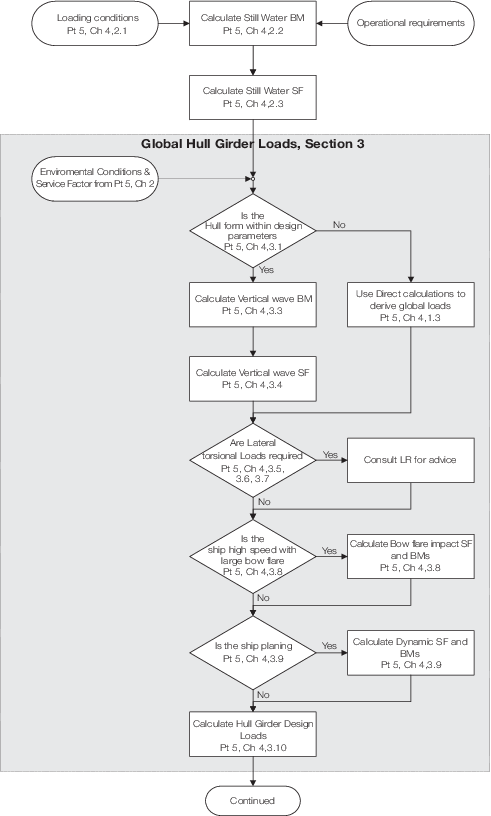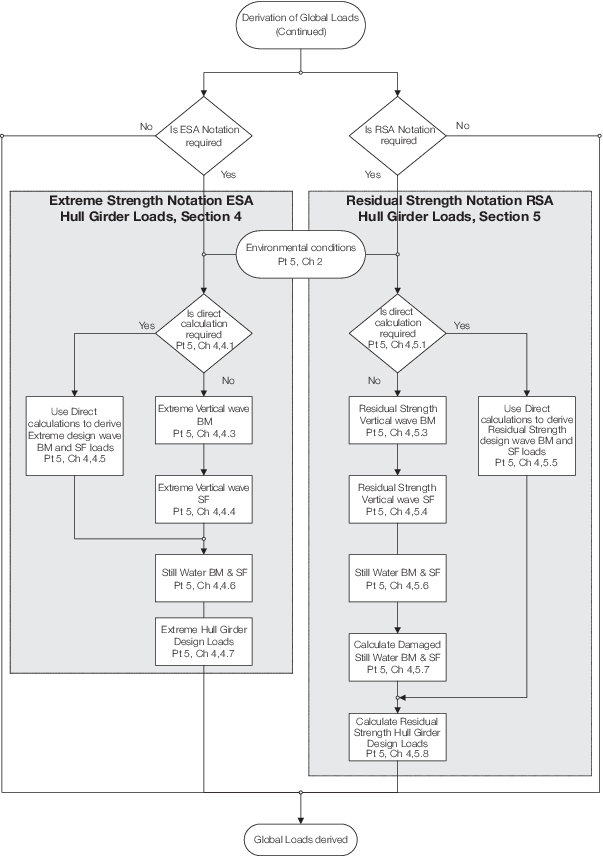
Section
1 General

1.1 Introduction
1.1.3 The
global design loads are divided into the following categories:
-
Hull girder loads.
The types of hull girder loads which are to be considered for
strength purposes in the initial design assessment are distinguished
on the basis of their frequency of occurrence and are defined as follows:
-
Still water
shear forces and associated bending moments arising from static mass
distribution and buoyancy forces, see
Vol 1, Pt 5, Ch 4, 2 Still water global loads.
-
Low frequency
vertical wave shear forces and associated bending moments arising
from hydrodynamic forces.
-
High frequency
dynamic shear forces and associated bending moments arising from slamming
events.
The derivation of the hull girder loads is
given in Vol 1, Pt 5, Ch 4, 3 Global hull girder loads.
-
Extreme hull girder
loads.
The loads to be considered for extreme hull girder
strength purposes are used to assess the hull girder structural capability
to withstand extreme sea states. The derivation of the extreme hull
girder loads is given in Vol 1, Pt 5, Ch 4, 4 Extreme hull girder loads.
-
Hull girder loads
for residual strength assessment.
The loads to be considered
for residual strength purposes are used to assess the structural capability
of the ship after damage to withstand moderately severe sea states.
The derivation of the residual strength hull girder loads is given
in Vol 1, Pt 5, Ch 4, 5 Residual strength hull girder loads.
1.1.4 Alternative
methods of establishing the global load and design criteria will be
specially considered, provided that they are based on model tests,
full scale measurements or other generally accepted theories. In such
cases, full details of the methods used and the results are to be
provided when plans are submitted for approval.

1.2 Definitions and symbols
1.2.1
L
R, B, B
WL, D and T are defined in Vol 1, Pt 3, Ch 1, 5 Definitions. F
n and Δ are defined in Vol 1, Pt 5, Ch 3, 1.3 Symbols and definitions 1.3.2 and Vol 1, Pt 5, Ch 3, 1.3 Symbols and definitions 1.3.1 respectively. Displacement
mode and non-displacement mode are defined in Vol 1, Pt 5, Ch 3, 1.3 Symbols and definitions.
1.2.2 For
longitudinal strength calculations of vertical shear force and bending
moment, downward loads are to be taken as positive values and are
to be integrated in the forward direction from the aft end of the
ship. Shear force is positive when the algebraic sum of all vertical
forces aft of the position is positive. Hogging bending moments are
to be taken as positive values.

1.3 Direct calculation procedures
1.3.1 The
still water longitudinal strength values are to be derived using a
suitable longitudinal strength calculation system.
1.3.2 In direct
calculation procedures capable of deriving the wave induced loads
on the ship account is to be taken of the ship’s actual form
and weight distribution.
1.3.3 Clasifications
Register’s (hereinafter referred to as 'LR') direct calculation
method of the long term wave induced loads involves derivation of
response to regular waves by strip theory, short-term response to
irregular waves using the sea spectrum concept, and long-term response
predictions using statistical distributions of sea states. Other direct
calculation methods submitted for approval are normally to contain
these three elements and produce similar and consistent results when
compared with LR’s methods.
1.3.4 The
long term response predictions are to be based on probability of 10–8. The LR long term prediction method produces values which have
a low statistical probability of occurring taking into account many
factors. These factors include:
- The operating life of the vessel, normally the operating life
is taken as 20 years which is assumed to correspond to 108 wave
encounters.
- The mission profile of the vessel.
- Different loading conditions.
- The effect of different wave headings on ship motions.

Figure 4.1.1 Procedure for the specification of global design loads

Figure 4.1.2 Procedure for the specification of global design loads (continued)

1.4 Information required
1.4.1 In order
that an assessment of the longitudinal strength requirements can be
made, the following information is to be submitted, in LR’s
standard format where appropriate:
-
General arrangement
and capacity plan or list showing details of the volume and position
of centre of gravity of all tanks, spaces and compartments.
-
Bonjean data,
in the form of tables or curves, for at least 21 equally spaced stations
along the hull together with a lines plan and/or tables of offsets.
-
Details of the
calculated lightweight and its distribution.
-
Details of the
weights and centres of gravity of all deadweight items for each of
the main loading conditions.
-
Calculated still
water bending moments and shear forces and the proposed design envelopes.
Calculated wave and dynamic bending moment and shear force values.
1.4.2 It is
recommended that this information be submitted in the form of a preliminary
Loading Manual or Stability Information Book including: specification
of operational requirements, hydrostatic data, details of loading
conditions, etc. It may also be necessary to submit a summary of the
damage stability analysis.
|
| Copyright 2022 Clasifications Register Group Limited, International Maritime Organization, International Labour Organization or Maritime
and Coastguard Agency. All rights reserved. Clasifications Register Group Limited, its affiliates and subsidiaries and their respective
officers, employees or agents are, individually and collectively, referred to in this clause as 'Clasifications Register'. Clasifications
Register assumes no responsibility and shall not be liable to any person for any loss, damage or expense caused by reliance
on the information or advice in this document or howsoever provided, unless that person has signed a contract with the relevant
Clasifications Register entity for the provision of this information or advice and in that case any responsibility or liability is
exclusively on the terms and conditions set out in that contract.
|
 |
|